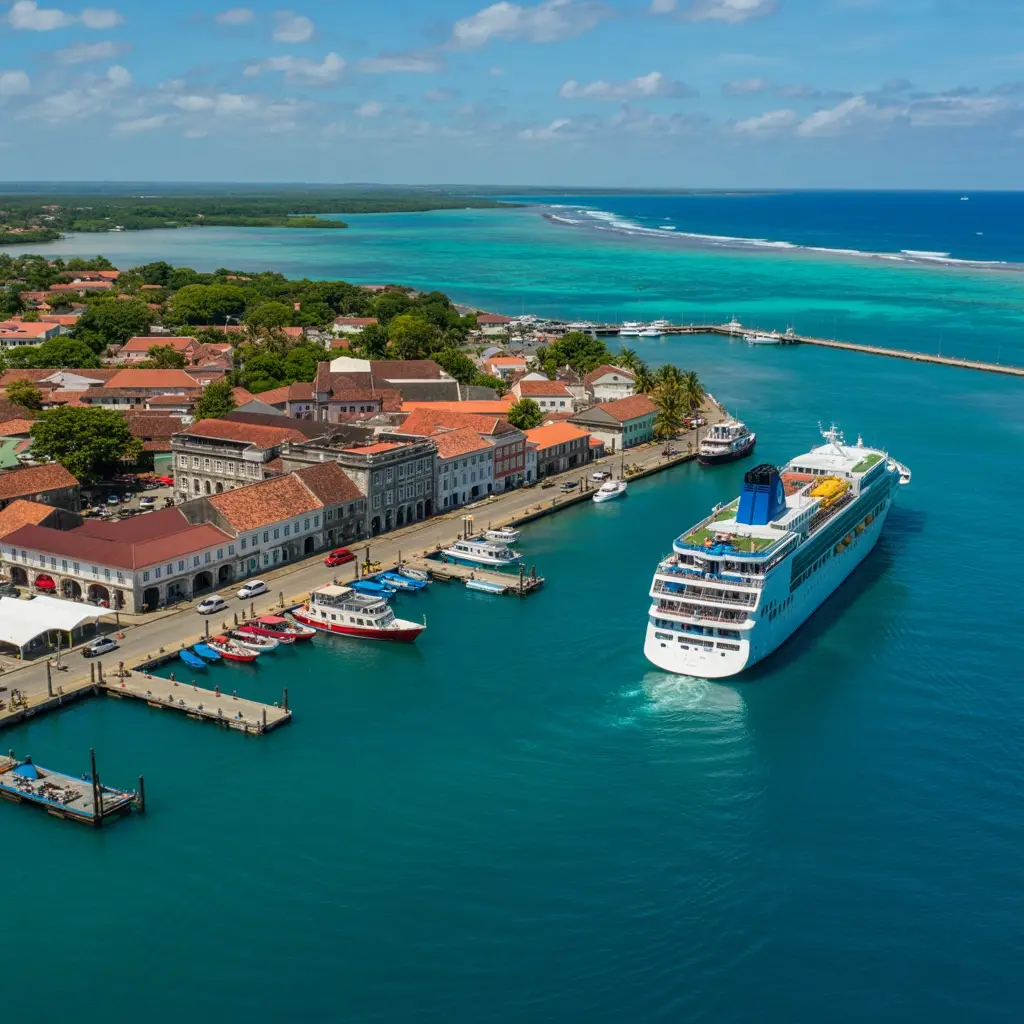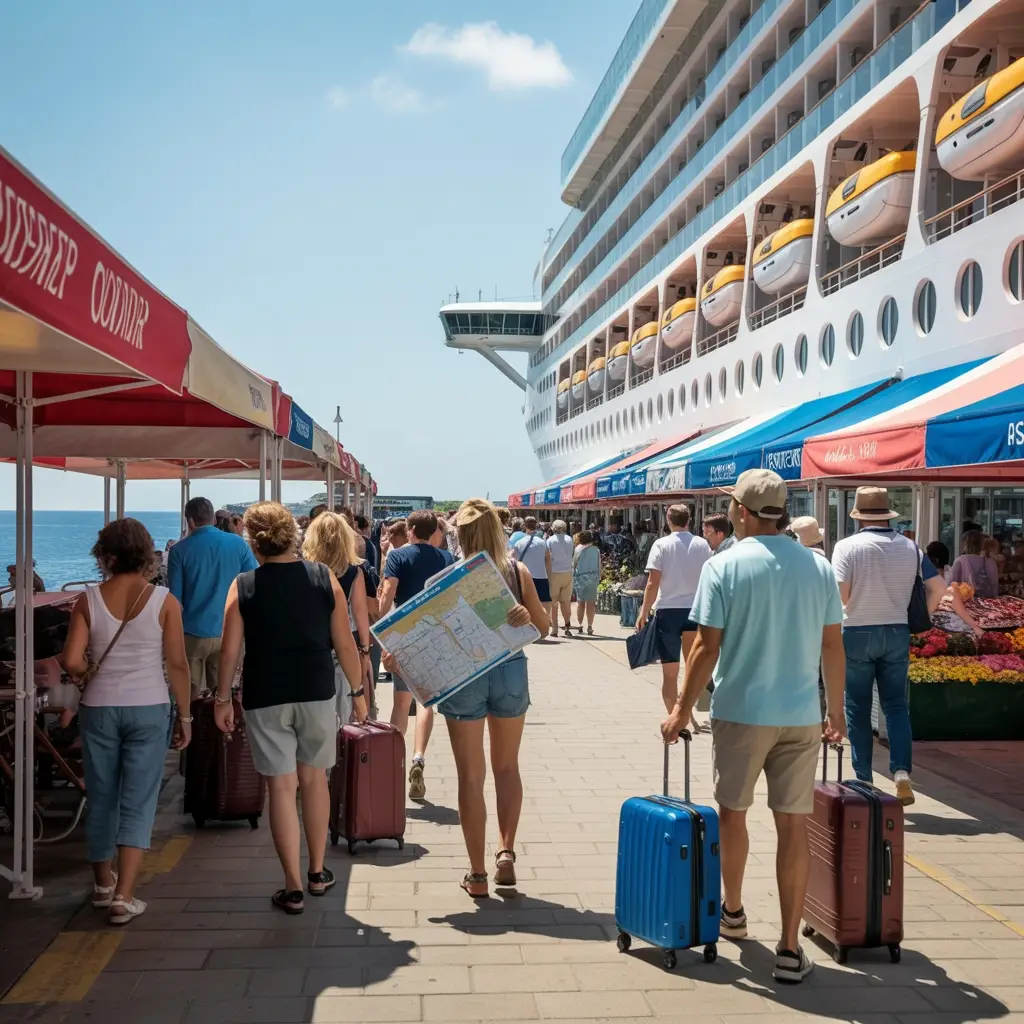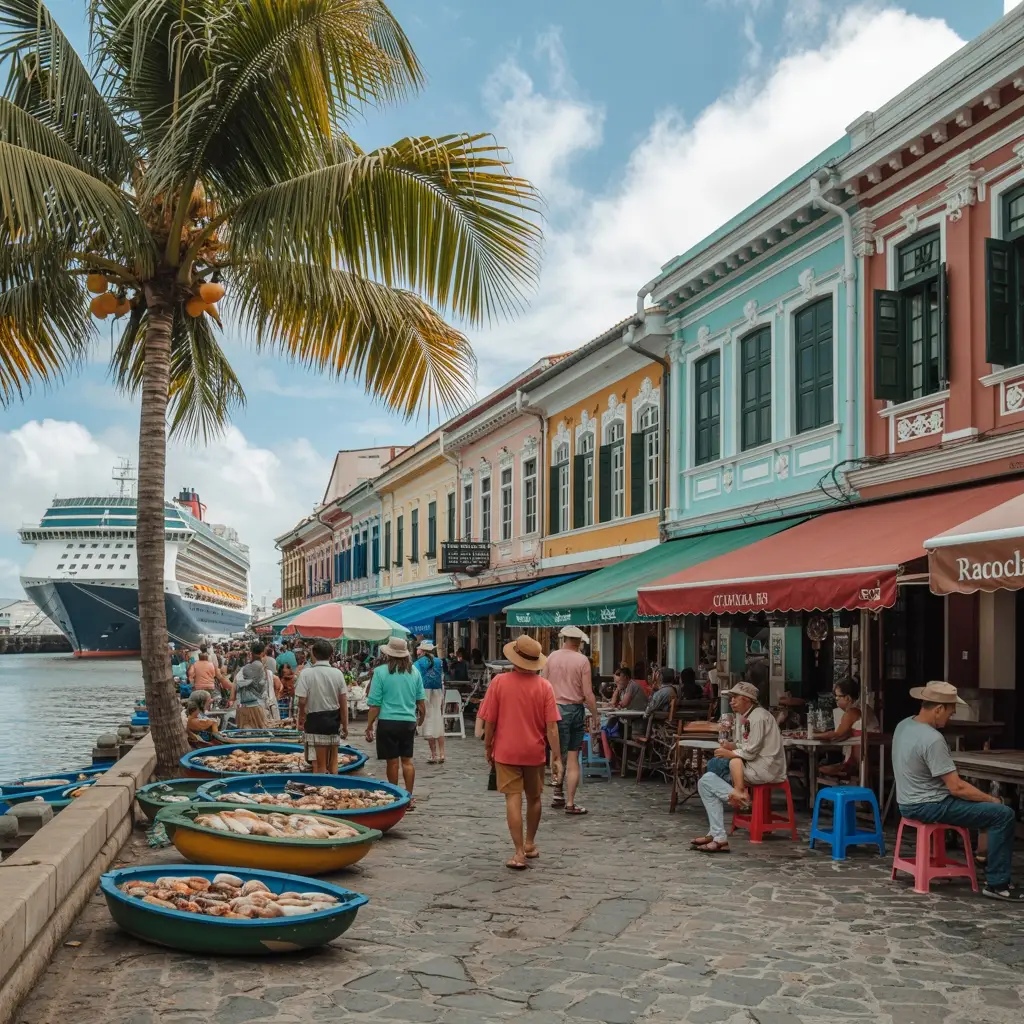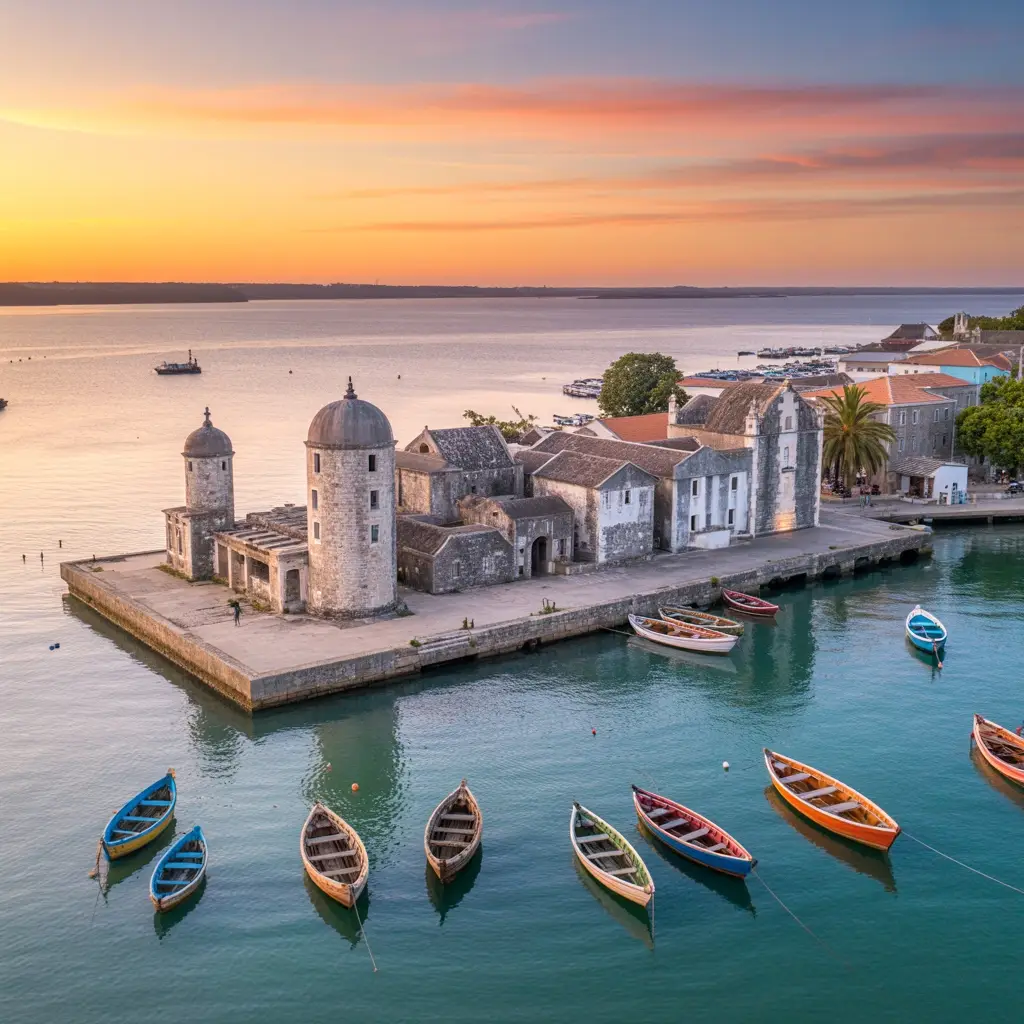Introduction to the Port

Envision this: your cruise ship anchors in the turquoise waters off a tiny coral island where centuries of history unfold like pages in a weathered manuscript. The salty breeze carries whispers of Portuguese explorers, Arab traders, and African traditions all woven together into something that’ll make you forget about that buffet lunch for a hot minute.
For other Mozambique Cruise destinations check out our Mozambique Cruise Ship Port Guide page.
Stone buildings rise from the shoreline with their weathered facades telling stories of when this little speck in the Indian Ocean was the bustling capital of Portuguese East Africa, and honestly, the UNESCO folks knew what they were doing when they slapped that World Heritage label on this place.
Now, here’s the thing about Ilha de Moçambique – your massive floating hotel isn’t pulling up to some gleaming modern terminal with escalators and duty-free shops. Nope, you’ll be taking a tender boat to this charming, slightly rough-around-the-edges port where the real journey begins the moment your feet hit the dock.
The logistics might seem a bit scattered at first, what with the smaller port facilities and the whole anchoring offshore situation, but trust me when I say that’s all part of the authentic charm.
We’re about to plunge into everything you need to know to navigate this historical gem like a pro, from those pesky port fees to the absolute must-see fortress that’s been standing guard here since the 1500s.
Map of Ilha de Moçambique Cruise Ship Port
Why Cruise From this Port?
This isn’t just another tropical port stop where you snap some selfies and buy overpriced souvenirs – this is your gateway to encountering one of Africa’s most authentic maritime crossroads where every weathered stone tells a story worth hearing.
- Strategic location connects you to broader Indian Ocean cruise routes including Madagascar and Tanzania
- UNESCO World Heritage Stone Town provides unmatched cultural immersion with zero tourist trap atmosphere
- Traditional dhows and 500-year-old fortifications create photo opportunities you literally can’t get anywhere else
- Community-led tours and artisan markets let you support local families while uncovering real Mozambican culture
- Intimate port encounter with smaller crowds means you actually get to explore without fighting through tour group bottlenecks
“What makes Ilha de Moçambique special for cruise passengers is that authenticity factor – you’re not getting some sanitized version of African culture here, you’re walking the same narrow streets where Portuguese traders haggled over gold and ivory centuries ago,” explains Captain Maria Santos, Port Authority Director.
“The island forces you to slow down, really absorb the history, and connect with our community in ways those massive commercial ports simply can’t provide.”
Cruise Terminal(s) Overview
When I think about cruise terminals, I picture these massive glass and steel complexes with endless escalators and duty-free shops stretching as far as the eye can see. Well, throw that mental image right out the window because Ilha de Moçambique operates on an entirely different wavelength.
The reality here is invigoratingly simple – you’ve got one main terminal facility that handles everything, and honestly, calling it a “terminal” might be giving it more credit than it deserves. This is more like a really well-organized port building that gets the job done without any fancy frills.
| Terminal | Facilities | Distance to City Centre | Walkable | Luggage Storage | WiFi Availability |
|---|---|---|---|---|---|
| Main Port Terminal | Ticket office, restaurant, souvenir shops, tourist info kiosk, currency exchange | 0.8 miles (15-minute walk) | Yes – flat coral paths | Limited portable system | Yes |
Here’s what you’re actually walking into when you disembark. The terminal sits right on Avenida 25 de Setembro, which sounds fancy but is basically the main road that runs along the waterfront. The building itself houses the essentials – ticket office for any last-minute ferry bookings, a restaurant where you can grab something that’s not cruise ship food, and those obligatory souvenir shops that somehow manage to be charming rather than touristy.
The whole setup screams “functional over flashy,” which I find oddly comforting. You’re not going to get lost wandering through multiple levels trying to find the exit. Everything you need is pretty much visible from wherever you’re standing.
Now, about those tender boats – if your ship is one of the larger ones, you’re definitely getting the authentic island arrival encounter via tender. The main quay can only handle smaller vessels, so anything over about 200 meters in length parks offshore and shuttles passengers back and forth. It’s actually kind of magical, approaching this coral island fortress from the water, watching those ancient walls grow larger as your tender chugs toward shore.
The passenger flow here maxes out around 1,200 people per day, which means you’re never dealing with those crushing crowds that make you question your life choices. Two mobile gangways handle the ships that can actually dock, and the whole baggage situation runs on a portable conveyor system that somehow manages to work better than some of those high-tech setups I’ve seen elsewhere.
What strikes me most about this terminal is how it forces you to slow down right from the moment you step onto the coral stone. No rushing, no pushing through crowds, no sensory overload from neon signs and announcements. Just you, the Indian Ocean breeze, and the immediate sense that you’ve arrived somewhere that operates on island time.
The WiFi actually works throughout the terminal area, which honestly surprised me more than it probably should have. Five international car rental agencies set up shop here, though I’m curious about what kind of driving encounter you’re expecting on a 2-mile-long island. The tourist information kiosk staff speaks multiple languages and seems genuinely enthusiastic about helping you figure out how to spend your time here.
Security runs 24/7 patrols around the terminal and quayside, plus they’ve got LED lighting that keeps everything visible after dark. There’s even an emergency medical station with actual paramedics, which gives you that extra peace of mind when you’re this far off the mainland.
The whole terminal encounter here strips away all the commercial cruise port nonsense and gets you straight to what you came for – stepping into a place where 500 years of maritime history is literally built into the coral stone beneath your feet.
Transport Options to the Port (From City Centre)

Getting around this coral island to reach your cruise ship is invigoratingly straightforward, with options ranging from zippy tuk-tuks to a pleasant stroll through UNESCO World Heritage streets.
| Transport Option | Cost Estimate (€/$) | Travel Time | Frequency | How to Book/Use |
|---|---|---|---|---|
| Tuk-Tuk (Auto Rickshaw) | €3-5 ($3-6) | 5-8 minutes | On-demand | Flag down near tourist areas or ask hotel to call |
| Walking | Free | 15 minutes | Always available | Follow Avenida 25 de Setembro waterfront road |
| Private Transfer | €15-25 ($18-30) | 5 minutes | Pre-booked | Reserve through cruise line or local tour operators |
| Local Taxi | €8-12 ($10-15) | 6-10 minutes | Limited during peak season | Negotiate fare upfront, find near city center |
| Bicycle Rental | €5-8 ($6-10) per day | 8-12 minutes | Daily rentals | Rent from shops near accommodations |
How to Get from the Airport to the Cruise Port
Getting from Nampula Airport to this UNESCO World Heritage island requires some planning since you’re looking at a solid 3.5-hour journey through rural Mozambique.
| Transport Option | Cost Estimate (€/$) | Travel Time | Booking Requirements | What’s Included |
|---|---|---|---|---|
| Private Transfer | €65-85 ($75-100) | 3.5-4 hours | Book 24-48 hours ahead | Flight tracking, door-to-door service, AC, luggage help |
| Cruise Line Shuttle | €90-120 ($100-140) | 3.5-4 hours | Book through cruise portal | Luggage handling, coordinated timing, motorcoach |
| Rental Car (4×4) | €45-65 ($50-75) per day | 3.5 hours driving | International permit required | Vehicle only, fuel extra, rough roads |
| Taxi | €45-60 ($50-70) | 3.5-4 hours | Negotiate at airport | Basic transport, limited English, no AC |
| Public Bus (Chapa) | €3-4 ($3-5) | 6+ hours | No booking needed | Multiple transfers, daylight only, very basic |
Parking and Accessibility at the Port
Parking at Ilha de Moçambique is honestly a bit of a puzzle since this UNESCO World Heritage island prioritizes preserving its historic charm over accommodating cars.
- No dedicated cruise parking – You won’t find a typical port parking lot here, so plan on parking off-site on the mainland or using local transport instead.
- Historic streets aren’t car-friendly – Those narrow, cobblestone pathways look gorgeous but they’re basically designed for people on foot, not your rental car.
- Expect a 10-20 minute walk – Any parking you do find will likely be outside the historic core, which means hauling your luggage across uneven terrain.
- Accessibility features are limited – The island’s ancient infrastructure doesn’t include wheelchair ramps or elevators, though cruise shuttles can help with mobility challenges.
- Taxis and tuk-tuks are your friends – Most smart travelers skip the parking headache entirely and use local transport to reach the terminal.
- Security is informal – Don’t expect guarded lots or surveillance systems, and definitely don’t leave valuables in your car if you do drive.
Common Mistakes First‑Time Cruisers Make at the port

First-time visitors to Ilha de Moçambique often stumble into avoidable headaches that can turn this magical UNESCO site into a stressful ordeal.
- Bringing fancy jewelry and designer bags – Those stunning local markets are also pickpocket paradise, so leave the bling on the ship and carry only what you need.
- Forgetting to print vaccination certificates – Digital copies won’t cut it here, and scrambling for internet access while officials wait isn’t fun.
- Wearing revealing clothes near mosques – This island takes modesty seriously around religious sites, so pack lightweight long sleeves and pants.
- Skipping malaria prevention – The CDC isn’t joking about this recommendation, even for short port visits.
- Using random taxi drivers – Stick with cruise-recommended transport or you might find yourself stranded when it’s time to return.
- Cutting departure time too close – Those charming dhow boats and tenders don’t run on cruise ship schedules, so give yourself extra buffer time.
- Drinking tap water during tours – Your stomach will thank you for sticking to bottled water, trust me on this one.
- Taking photos of government buildings – That innocent snapshot could land you in serious trouble with local authorities.
See what’s on offer from the Port of Pemba for a different Mozambique Cruise destination.
Things to do Near The Port
The port area puts you right in the thick of Stone Town’s historic treasures, so you won’t waste precious time getting to the good stuff.
- Fortaleza de São Sebastião – This 1608 Portuguese fort gives you killer panoramic views and enough history to make your head spin.
- Nossa Senhora de Baluarte – The oldest European church in the Southern Hemisphere, because apparently someone was keeping track of these things back in 1522.
- Palace and Chapel of São Paulo – Now a museum packed with colonial artifacts that’ll transport you straight back to 1610.
- Stone Town’s narrow streets – Get wonderfully lost wandering past Swahili-style houses and colonial buildings that Instagram dreams are made of.
- Governor’s Palace Museum – Plunge deep into local history and trade exhibits, perfect for when you want to actually learn something between beach days.
- Local markets – Grab handmade jewelry, batik fabrics, and watch your haggling skills get put to the test.
- Traditional dhow boats – These lateen-rigged beauties haven’t changed their design in centuries, and honestly, why fix what isn’t broken.
Short Walks Close to the Port
You can easily explore this UNESCO World Heritage site on foot since everything worth seeing clusters within walking distance of where your ship docks.
| Name | Start Point | Distance | Time Needed | Highlights |
|---|---|---|---|---|
| Historical Landmarks Walk | Port entrance | 1 km | 2-3 hours | Fort São Sebastião panoramic views, Chapel of Nossa Senhora de Baluarte, Stone Town colonial mansions, Museum of Sacred Art |
| Cultural Immersion Walk | Port market area | 800m | 1.5-2 hours | Makuti Town traditional neighborhood, artisan workshops, community fish market, local bread vendors |
| Coastal Exploration Walk | Eastern port edge | 1.2 km | 2 hours | Kathiawar shipwreck views, coral garden viewpoints, dhow boatyards, sunset watching spots |
| Trade Route History Walk | Port waterfront | 600m | 1-2 hours | Missanga trade paths, Portuguese warehouses, Persian merchant tombs, maritime archaeology sites |
Dining and Shops Within Walking Distance of the Port

You’ll find some delightful local spots just steps from where your ship docks, though I should mention the selection is charmingly small since this is a historic island rather than a bustling commercial port.
- Café Azulejo – Right near the Port Captain’s office, perfect for morning coffee, fresh sandwiches, and local Mozambican dishes when you need a quick bite between exploring.
- Sara’s Place – A snug spot serving fresh seafood and vegetarian options, plus the owner usually speaks decent English which makes ordering so much easier.
- Escondidinho – Treasure serving African and seafood fusion dishes, though you might need to ask locals for directions since it’s tucked away in the old Stone Town.
- Pé na areia – Beach bar on Nankharamu Beach with grilled seafood and cold drinks, about a 10-minute walk along the coast.
- Local craft vendors – Small stalls near the port selling traditional makuti weavings, wooden dhow models, and colorful capulanas that make perfect souvenirs.
- Spice merchants – Tiny shops in Stone Town providing locally grown cashews, coconut products, and aromatic spices like cardamom and cinnamon.
Emergency Contacts at the Port
While I hope you’ll never need these numbers, it’s smart to save them in your phone right when you board since cell service can be spotty on this remote island.
- Police emergencies – Dial 112 for immediate response, though keep in mind this is a small island so response times vary.
- Fire department – +258 82 476 8990 for any fire-related emergencies at the port or nearby areas.
- Medical emergencies – Contact Aeromed air ambulance at 845555911, 84911, or 82911 since serious cases need mainland transfer.
- Maritime emergencies – Use VHF Channel 16 to reach port authorities, especially for any water-related incidents.
- Your embassy – Canadian High Commission (+258 21 48 5500) or U.S. Embassy (+258 21 35 0000) in Maputo, though they’re about 76km away.
- Port security – Available on-site for immediate incidents, and they’re required to report anything serious within 2 hours to maritime authorities.
Environmental Initiatives at the Port
As a UNESCO World Heritage site, Ilha de Moçambique has developed impressive environmental initiatives that’ll make you feel good about visiting this historic port.
You’ll notice renewable energy systems powering port infrastructure and strict ballast water regulations protecting marine ecosystems. The port operates coral reef monitoring programs and real-time water quality tracking through oceanographic sensors.
You can participate in quarterly beach cleanups and enjoy single-use plastic-free facilities. The port limits daily passenger numbers, uses traditional building techniques for authentic preservation, and operates “silent berthing” with electric tugs.
Community workshops and school programs actively engage locals in conservation efforts.
Brief History of the Port

Behind these modern conservation efforts lies a remarkable maritime legacy stretching back over 700 years.
You’re visiting a port that began as a 1300s Swahili trading post, connecting Africa’s gold and ivory to Indian Ocean merchants. When Portuguese explorers arrived in 1498, they transformed this strategic location into their East African headquarters by 1507.
For centuries, you’re standing where ships loaded precious cargo bound for Brazil, Goa, and beyond. The Portuguese built Fort São Sebastião in 1558 to protect these lucrative trade routes.
Though Maputo became Mozambique’s capital in 1898, this UNESCO World Heritage site preserves its extraordinary maritime history.
Frequently Asked Questions
What Vaccinations Are Required Before Visiting Ilha De Moçambique?
You’ll need yellow fever vaccination if arriving from risk countries, plus an International Certificate of Vaccination. COVID-19 vaccines are recommended for travelers 12+, and measles-mumps-rubella proof is advised.
Can I USe US Dollars or Do I Need Local Currency?
You’ll need local currency (Mozambican Metical – MZN) since US dollars aren’t widely accepted in local businesses. You can withdraw MZN from ATMs or exchange USD at banks for better rates.
What Is the Best Time of Year to Cruise to This Port?
You’ll find September through November provides the best cruising conditions. You’ll enjoy calm seas, clear skies, comfortable temperatures around 81-90°F, and excellent whale watching opportunities during humpback migration season.
Are There ATMS Available Near the Cruise Port Area?
You’ll find ATMs in nearby mainland towns, not directly at the cruise terminal. You’ll need to travel a short distance from the port to reach them in adjacent urban areas.
What Should I Pack for Shore Excursions in Mozambique’s Climate?
Pack lightweight, breathable clothing, reef-safe SPF 50+ sunscreen, wide-brimmed hat, waterproof rain jacket, insect repellent, reusable water bottle, electrolyte tablets, modest attire for villages, and waterproof bags for electronics protection.
Thinking about something different? Check out the cruises leaving from Inhambane Cruise Ship Port.
